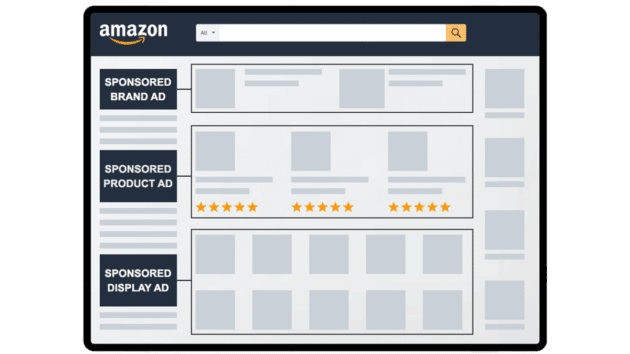Amazon has over 12 million product listings (and counting). The competition is a threat to new and old sellers alike. Fortunately, sellers can use advertising to promote their goods and boost sales through Amazon PPC.
A decent Amazon Pay-per-Click advertising strategy can raise brand recognition, improve product visibility, increase SERP, and contribute to sales. However, there is definitely a learning curve involved. PPC strategies are often a mixture of trial-and-error techniques. Plus, there are a lot of technicalities you have to juggle, including ACoS, impressions, clicks, and conversions. But, with PPC done right, getting good traffic on Amazon becomes quite convenient.
Feeling the pressure? Do not worry; we’ll show you how to properly plan out the best Amazon PPC campaign utilizing simple tactics.
What is Amazon PPC?

Amazon PPC is an advertising model for Amazon merchants. They can create attractive ads, and Amazon publishes them across its platform and network. Ad owners are charged when a user clicks on their ad. The merchant is free to design and alter campaigns to advance product sales and profitability. A dynamic bidding process determines the cost-to-click.
Basic Phrases in Amazon PPC
Amazon Pay-Per-Click advertising is a multi-layer process with many technical aspects to it. But don’t worry; we’ve got you covered.

Recommended for you: Applying Big Data to Advantage Your Social Media Advertising.
1. Keywords
Keywords, also known as search terms, are phrases that shoppers enter using the Amazon search box to browse specific products in the marketplace. By including these highly-search keywords, merchants improve the exposure and ranking of their Amazon product listing.
2. Impressions
Impressions represent how many times a user views an advertisement on Amazon.
3. Clicks
Users’ number of clicks on the advertisement represents clicks.
4. CTR (Click-Through-Rate)
The click-through rate (CTR) is the ratio of clicks to impressions. For example, if one user clicked your advertisement after it had been displayed 100 times, the CTR would be 1%.
5. Conversion Rate
The conversion rate is the proportion of sales to total clicks. Thus, if you had ten clicks and 4 of them resulted in sales, your conversion rate would be 40%.

6. ACoS (Advertising Cost of Sale)
Advertising Cost of Sales is one of the most important criteria for determining an Amazon PPC campaign’s profitability. It alludes to the amount of money spent on advertisements compared to sales. Therefore, your ACoS is 20% if you spent $20 on advertising and received $100 in sales.
7. RoAS (Return on Ad Spend)
Return on Ad Spend, the opposite of ACoS, is a metric used to measure the success of Amazon PPC campaigns. For instance, if you spent $20 on advertising and made $100, your RoAS would be 10:2.
8. CPC (Cost-Per-Click)
Cost-Per-Click is a metric that helps advertisers calculate the cost per click. The advertiser pays Amazon the bid value specified in the Campaign Manager on Seller Central when a customer clicks on an ad.
9. Automatic Targeting
An option in Amazon advertising campaigns called “automatic targeting” gives Amazon control over how your ads are configured. This choice, specifically Amazon PPC, is ideal for advertisers just getting started with advertising.
10. Manual Targeting
Advertisers can alter the campaign settings, unlike automatic targeting. Both advertisers with Amazon PPC experience and newbies who want to test the waters on the platform should choose this option.
Types of Amazon PPC Ads

There are three categories of Amazon Pay-Per-Click:
- Sponsored Brands.
- Sponsored Displays.
- Sponsored Products.
Each has individual qualities and advantages that you may use to properly run these kinds of campaigns.
1. Sponsored Products
Sponsored Products are Pay-Per-Click advertisements that show your ad above, next to, or inside the results of an Amazon search. They can also be shown on product pages in desktop and mobile modes. When utilizing Sponsored Products advertisements, ASINs often bring positive results. It not only increases the number of impressions on your Amazon product listing but also improves how purchasers perceive your product.
2. Sponsored Brands
Sponsored brands appear in the marketplace similarly to sponsored product ads. However, brands registered with the Amazon Brand Registry can only use this sort of Amazon advertisement. For new and developing brands, sponsored brands are advised. This is because they successfully raise brand recognition among their intended audience.
3. Sponsored Displays
Both on and off Amazon, sponsored display ads can appear. In addition, with its subsidiaries and third-party partner websites, Amazon can display advertisements in mobile, desktop, and app views.
These three Amazon PPC ad types are self-service, allowing advertisers to edit their advertisements and oversee their campaigns on their own. Amazon doesn’t interfere with adverts; you have complete control over the information you want to change. Remember that since all these advertisements are CPC, you will only be required to compensate Amazon when a customer clicks on your advertisement. Each click has a bid, and the bigger the bid, the more probable it will appear to an Amazon shopper.
You may like: How to Use 3D Modeling in Business Promotion & Advertising?
The Best Amazon PPC Strategy for Effective Results

Numerous tactics can be used when advertising on this giant marketplace. These practices are constantly evolving to meet the target market’s shifting needs. While making money is still a company’s main objective when employing Amazon PPC-sponsored advertisements, you can tailor your effort to support other goals, such as raising brand awareness by offering sales.
1. Conduct Research
This phase demands the most remarkable results and takes time and work. You will dramatically increase your expertise to help you succeed with your Amazon PPC-sponsored ad campaigns by investigating search phrases (keywords), audience insights, product targeting, trends, news, and other topics. One of the key objectives of thorough research is to find the right set of keywords for your campaign. A new seller should go for long-tail keywords as these can help you match user queries and reach your target audience much easier. Additionally, such key phrases are more specific and have comparatively less search traffic than short-tail keywords.
2. Test Your Strategy
After researching, you can create a strategy that best meets your business requirements. Some merchants handle this phase well, but new sellers frequently seek advice from qualified Amazon PPC management services providers.
- When testing a search phrase, one clever technique is to choose automatic targeting and then leave it running for a week with a low budget. During this time, data can be gathered to see whether or not a specific keyword campaign is successful. If it does, you can utilize this information for manual targeting to make the most of it.
- Another technique you can use to test your ad is setting up three different ad campaigns. Make sure that you set different bids with different budgets and use different creatives and keywords in all three sets. By running three different sets, you will get a fair idea about which keywords are working well for you. You should skip the Keywords that rank your product on page 5 and beyond and should prefer more specific keywords. If the keyword ranks your product on the 2nd or 3rd page, you can choose those keywords and blend them with the one yielding the highest results. You should bid consistently and keep checking which keywords are generating more sales. Initially, this can be a bit expensive, but with time, as you identify the keywords that work for you, you will generate higher sales by spending less.

3. Analyze the Results
The effectiveness of your advertising efforts is examined using several key measures, including RoAS and ACoS:
- RoAS (Return on Ad Spend): Reveals the amount of money you make for each dollar spent on advertising.
- ACoS (Advertising Cost of Sales): How much did you spend on advertising to get a dollar from the allocated sale?
Analyze the results and determine which campaigns efficiently produced sales with less marketing expense. These campaigns can be strengthened, while underperforming ones can be turned off. To ensure that Amazon reflects the precise data from your Campaign Manager, outcomes should be monitored at least once every week.
4. Apply Success Criteria & Then Repeat Steps 1, 2, & 3
After your campaigns have produced results, you can repeat this tactic to increase your sales and earnings on other lucrative keywords. The keywords and images used in your Amazon product listings significantly impact CPC results. Product pictures and videos persuade shoppers to click the Buy button. Furthermore, you can scale your eCommerce business effectively by tracking your data and creating powerful campaigns.
You may also like: How to Use Twitter, Facebook & Instagram in Your Online Advertising Campaign?
Final Thoughts

There is too much competition on Amazon for you to rely just on the quality of your goods to generate sales. Instead, you must figure out how to make your product extremely noticeable to draw customers in this crowded market. Your chances of making a sale increase with how easily people can find your goods.
Amazon Pay-Per-Click sponsored advertising is the key to obtaining product exposure. You can decide whether you’ll appear higher in product searches by placing bids on keywords. PPC is undoubtedly an additional expense for your budget. Still, by carefully planning and running your campaigns, you can reduce advertising costs and increase product visibility and sales, taking your business to great success heights.
This article is written by Jessica Campbell. Jessica is a digital marketing enthusiast who works as an Amazon listing services in SAMM Data Services. With 20+ years of experience in the eCommerce industry, she has helped hundreds of Amazon sellers reach their target business objectives regardless of their chosen processes & product categories.





